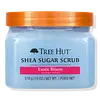What's inside
What's inside
 Key Ingredients
Key Ingredients

 Benefits
Benefits

 Concerns
Concerns

 Ingredients Side-by-side
Ingredients Side-by-side

Sucrose
HumectantGlycerin
HumectantPolysorbate 20
EmulsifyingSilica
AbrasiveAloe Barbadensis Leaf Juice
Skin ConditioningButyrospermum Parkii Butter
Skin ConditioningOenothera Biennis Oil
EmollientCitrus Aurantium Dulcis Oil
MaskingMacadamia Ternifolia Seed Oil
EmollientPrunus Amygdalus Dulcis Oil
Skin ConditioningCarthamus Tinctorius Seed Oil
MaskingPersea Gratissima Oil
Skin ConditioningCannabis Sativa Seed Oil
EmollientLavandula Angustifolia Oil
MaskingRetinyl Palmitate
Skin ConditioningAscorbic Acid
AntioxidantWater
Skin ConditioningParfum
MaskingSorbic Acid
PreservativeSucrose, Glycerin, Polysorbate 20, Silica, Aloe Barbadensis Leaf Juice, Butyrospermum Parkii Butter, Oenothera Biennis Oil, Citrus Aurantium Dulcis Oil, Macadamia Ternifolia Seed Oil, Prunus Amygdalus Dulcis Oil, Carthamus Tinctorius Seed Oil, Persea Gratissima Oil, Cannabis Sativa Seed Oil, Lavandula Angustifolia Oil, Retinyl Palmitate, Ascorbic Acid, Water, Parfum, Sorbic Acid
Glycerin
HumectantWater
Skin ConditioningSodium Laureth Sulfate
CleansingBambusa Vulgaris Extract
Skin ConditioningNacre Powder
AbrasivePrunus Amygdalus Dulcis Oil
Skin ConditioningPropylene Glycol
HumectantBertholletia Excelsa Seed Oil
EmollientButyrospermum Parkii Butter
Skin ConditioningStearic Acid
CleansingArgania Spinosa Kernel Oil
EmollientButter
Skin ConditioningLavandula Angustifolia Oil
MaskingVaccinium Angustifolium Fruit Juice
AstringentCitric Acid
BufferingTheobroma Cacao Seed Butter
EmollientChondrus Crispus Extract
Skin ConditioningTitanium Dioxide
Cosmetic ColorantTalc
AbrasiveTriethanolamine
BufferingCetearyl Alcohol
EmollientSynthetic Fluorphlogopite
Tin Oxide
AbrasiveCoumarin
PerfumingGeraniol
PerfumingLimonene
PerfumingLinalool
PerfumingCI 77491
Cosmetic ColorantCI 45410
Cosmetic ColorantCI 77499
Cosmetic ColorantGlycerin, Water, Sodium Laureth Sulfate, Bambusa Vulgaris Extract, Nacre Powder, Prunus Amygdalus Dulcis Oil, Propylene Glycol, Bertholletia Excelsa Seed Oil, Butyrospermum Parkii Butter, Stearic Acid, Argania Spinosa Kernel Oil, Butter, Lavandula Angustifolia Oil, Vaccinium Angustifolium Fruit Juice, Citric Acid, Theobroma Cacao Seed Butter, Chondrus Crispus Extract, Titanium Dioxide, Talc, Triethanolamine, Cetearyl Alcohol, Synthetic Fluorphlogopite, Tin Oxide, Coumarin, Geraniol, Limonene, Linalool, CI 77491, CI 45410, CI 77499
Ingredients Explained
These ingredients are found in both products.
Ingredients higher up in an ingredient list are typically present in a larger amount.
This ingredient is also known as shea butter. It is an effective skin hydrator and emollient.
Emollients help soothe and soften your skin. It does this by creating a protective film on your skin. This barrier helps trap moisture and keeps your skin hydrated. Emollients may be effective at treating dry or itchy skin.
Shea butter is rich in antioxidants. Antioxidants help fight free-radicals, or molecules that may harm the body. It is also full of fatty acids including stearic acid and linoleic acid. These acids help replenish the skin and keep skin moisturized.
While Shea Butter has an SPF rating of about 3-4, it is not a sunscreen replacement.
Shea butter may not be fungal acne safe. We recommend speaking with a professional if you have any concerns.
Learn more about Butyrospermum Parkii ButterGlycerin is already naturally found in your skin. It helps moisturize and protect your skin.
A study from 2016 found glycerin to be more effective as a humectant than AHAs and hyaluronic acid.
As a humectant, it helps the skin stay hydrated by pulling moisture to your skin. The low molecular weight of glycerin allows it to pull moisture into the deeper layers of your skin.
Hydrated skin improves your skin barrier; Your skin barrier helps protect against irritants and bacteria.
Glycerin has also been found to have antimicrobial and antiviral properties. Due to these properties, glycerin is often used in wound and burn treatments.
In cosmetics, glycerin is usually derived from plants such as soybean or palm. However, it can also be sourced from animals, such as tallow or animal fat.
This ingredient is organic, colorless, odorless, and non-toxic.
Glycerin is the name for this ingredient in American English. British English uses Glycerol/Glycerine.
Learn more about GlycerinLavandula Angustifolia Oil is more commonly known as lavender essential oil. It is considered a fragrancing ingredient.
Lavender imparts a famous scent. While the smell is lovely, this ingredient and may sensitize skin in topical products. This is because about 85% of the oil is made up of linalool and linalyl acetate.
When exposed to air, these two compounds become strong allergens. This ingredient exhibits cytotoxicity at low concentrations; amounts of 0.25% have been shown to damage skin cells.
A study from Japan found this ingredient caused lavender sensitivity after widespread exposure.
Lavender essential oil has some antimicrobial, antibacterial, and anti-inflammatory properties. However, the cons of this ingredient may outweight the pros.
More research is needed to confirm lavender essential oil's effects when used in aromatherapy.
Lavandula Angustifolia is known as the English Lavender and famous for creating purple fields in Provence, France.
Learn more about Lavandula Angustifolia OilPrunus Amygdalus Dulcis Oil comes from the sweet almond, a tree native to Iran. This oil has no fragrance and is non-volatile.
Almonds contain healthy fats, vitamins, and minerals. It is a rich source of Vitamin E, a great antioxidant and skin conditioning ingredient. Sweet almond oil contains fatty acids such as linolenic acid and triglycerides.
The content of sweet almond oil makes it a great emollient; it can help soften and hydrate your skin. Emollients create a barrier over your skin to trap moisture in. Sweet almond oil has antioxidant properties.
Those with an almond allergy should be careful of this ingredient and speak with a professional about using it in your skincare.
This ingredient may not be fungal-acne safe.
Learn more about Prunus Amygdalus Dulcis OilWater. It's the most common cosmetic ingredient of all. You'll usually see it at the top of ingredient lists, meaning that it makes up the largest part of the product.
So why is it so popular? Water most often acts as a solvent - this means that it helps dissolve other ingredients into the formulation.
You'll also recognize water as that liquid we all need to stay alive. If you see this, drink a glass of water. Stay hydrated!
Learn more about Water